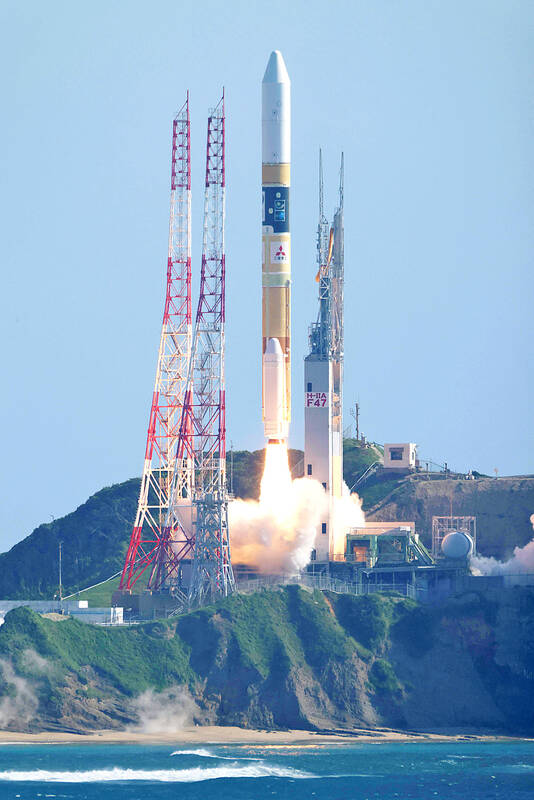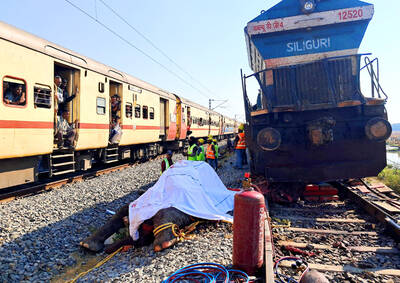Japan’s “Moon Sniper” spacecraft this weekend is scheduled to attempt a historic touchdown on the lunar surface using pinpoint technology that the country hopes would lead to success where many have failed.
With its Smart Lander for Investigating Moon (SLIM) mission, Japan wants to become the fifth nation to pull off a fiendishly tricky soft landing on the rocky surface.
Only the US, the former Soviet Union, China and India have accomplished the feat, and Japan’s lander — equipped with a rolling robot developed by a major toy company — is designed to do so with unprecedented precision.

Photo: AFP / Japan Aerospace Exploration Agency
The descent of the lightweight SLIM craft, nicknamed the “Moon Sniper” by the Japan Aerospace Exploration Agency (JAXA), is scheduled to start at midnight on Saturday.
If all goes to plan, the touchdown would be about 20 minutes later.
The craft is targeting an area within 100m of a spot on the lunar surface — far less than the usual landing zone of several kilometers.
Success would reverse Japan’s fortunes in space after two failed lunar missions and recent rocket failures, including explosions after takeoff.
It would also echo the triumph of India’s low-cost space program in August last year, when the country became the first to land an uncrewed craft near the moon’s largely unexplored south pole.
SLIM is expected to land on a crater where the moon’s mantle — the inner layer beneath its crust — is believed to be accessible at the surface.
“The rocks exposed here are crucial in the search for the origins of the moon and the Earth,” said Tomokatsu Morota, an associate professor at the University of Tokyo specializing in lunar and planetary exploration.
JAXA has already made a pinpoint landing on an asteroid, but the challenge is greater on the moon, where gravity is stronger.
With just one shot at landing, the pressure is on — and the craft’s precision is vital in the attempt to “land on an area surrounded by rocks,” which it would examine with a camera, Morota said.
With its “sniper” technology, Japan hopes to “showcase its presence” in space and provide pivotal information on the moon’s history, he said.
The mission also has ambitions to shed light on the mystery of water resources that are the key to building bases on the moon.
The lunar surface is desert-like, but at the poles, where the terrain is rugged and sunlight is scarce, there are areas where water could exist.
“The possibility of lunar commercialization depends on whether there is water at the poles,” Morota said.
SLIM’s rolling probe, slightly bigger than a tennis ball, can change its shape to move on the moon’s surface. It was jointly developed by JAXA and Japanese toy giant Takara Tomy.
Adding to the playful mood, JAXA has released an online video game called SLIM: The pinpoint moon-landing game.
More than 50 years after the first human moon landing, countries and private companies are racing to make the trip anew.
However, crash-landings, communication failures and other technical problems are rife.
This month, a private US lunar lander had to turn back after leaking fuel, while NASA postponed plans for crewed lunar missions under its Artemis program.
Russia, China and other countries from South Korea to the United Arab Emirates are also trying their luck.
Previous Japanese lunar missions — one public and one private — have failed twice.
In 2022, the country unsuccessfully sent a lunar probe named Omotenashi as part of the US’ Artemis 1 mission.
In April, Japanese start-up ispace tried in vain to become the first private company to land on the moon, losing communication with its craft after what it described as a “hard landing.”

The Burmese junta has said that detained former leader Aung San Suu Kyi is “in good health,” a day after her son said he has received little information about the 80-year-old’s condition and fears she could die without him knowing. In an interview in Tokyo earlier this week, Kim Aris said he had not heard from his mother in years and believes she is being held incommunicado in the capital, Naypyidaw. Aung San Suu Kyi, a Nobel Peace Prize laureate, was detained after a 2021 military coup that ousted her elected civilian government and sparked a civil war. She is serving a

REVENGE: Trump said he had the support of the Syrian government for the strikes, which took place in response to an Islamic State attack on US soldiers last week The US launched large-scale airstrikes on more than 70 targets across Syria, the Pentagon said on Friday, fulfilling US President Donald Trump’s vow to strike back after the killing of two US soldiers. “This is not the beginning of a war — it is a declaration of vengeance,” US Secretary of Defense Pete Hegseth wrote on social media. “Today, we hunted and we killed our enemies. Lots of them. And we will continue.” The US Central Command said that fighter jets, attack helicopters and artillery targeted ISIS infrastructure and weapon sites. “All terrorists who are evil enough to attack Americans are hereby warned

Seven wild Asiatic elephants were killed and a calf was injured when a high-speed passenger train collided with a herd crossing the tracks in India’s northeastern state of Assam early yesterday, local authorities said. The train driver spotted the herd of about 100 elephants and used the emergency brakes, but the train still hit some of the animals, Indian Railways spokesman Kapinjal Kishore Sharma told reporters. Five train coaches and the engine derailed following the impact, but there were no human casualties, Sharma said. Veterinarians carried out autopsies on the dead elephants, which were to be buried later in the day. The accident site

‘NO AMNESTY’: Tens of thousands of people joined the rally against a bill that would slash the former president’s prison term; President Lula has said he would veto the bill Tens of thousands of Brazilians on Sunday demonstrated against a bill that advanced in Congress this week that would reduce the time former president Jair Bolsonaro spends behind bars following his sentence of more than 27 years for attempting a coup. Protests took place in the capital, Brasilia, and in other major cities across the nation, including Sao Paulo, Florianopolis, Salvador and Recife. On Copacabana’s boardwalk in Rio de Janeiro, crowds composed of left-wing voters chanted “No amnesty” and “Out with Hugo Motta,” a reference to the speaker of the lower house, which approved the bill on Wednesday last week. It is